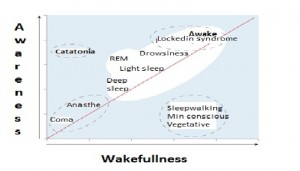 Okay, here is your starter for 10 – your time starts now! (If you’re not familiar with this phrase, it relates to the quiz show ‘University challenge’, which was on British television for many years.)
Okay, here is your starter for 10 – your time starts now! (If you’re not familiar with this phrase, it relates to the quiz show ‘University challenge’, which was on British television for many years.)
The question is: how many states of consciousness are there?
I can almost see your mind tripping up and reading that question again. Surely, you will say, there are three states of consciousness – waking, dreaming and deep sleep. What can I possibly mean by querying this? Well, actually, depending upon how you answer this question, the number of states of consciousness could be two, three or five (or 4 ½) or you could argue that the very question is misconceived!
It is true that most of the scriptures refer to 3 states. If you have read my book ‘A-U-M: Awakening to Reality’, you will know that it refers to jAgrat, svapna and suShupti. These three states are mithyA and the reality underlying them is called turIya. In the tattva bodha (attributed to Shankara), the question is asked: avasthAtrayaM kim? – What are the three states? Admittedly, this is a somewhat leading question but the answer is given: jAgratsvapnasuShuptyavasthAH – they are the waking, dream and deep sleep states. And it goes on to explain each in turn. Continue reading

